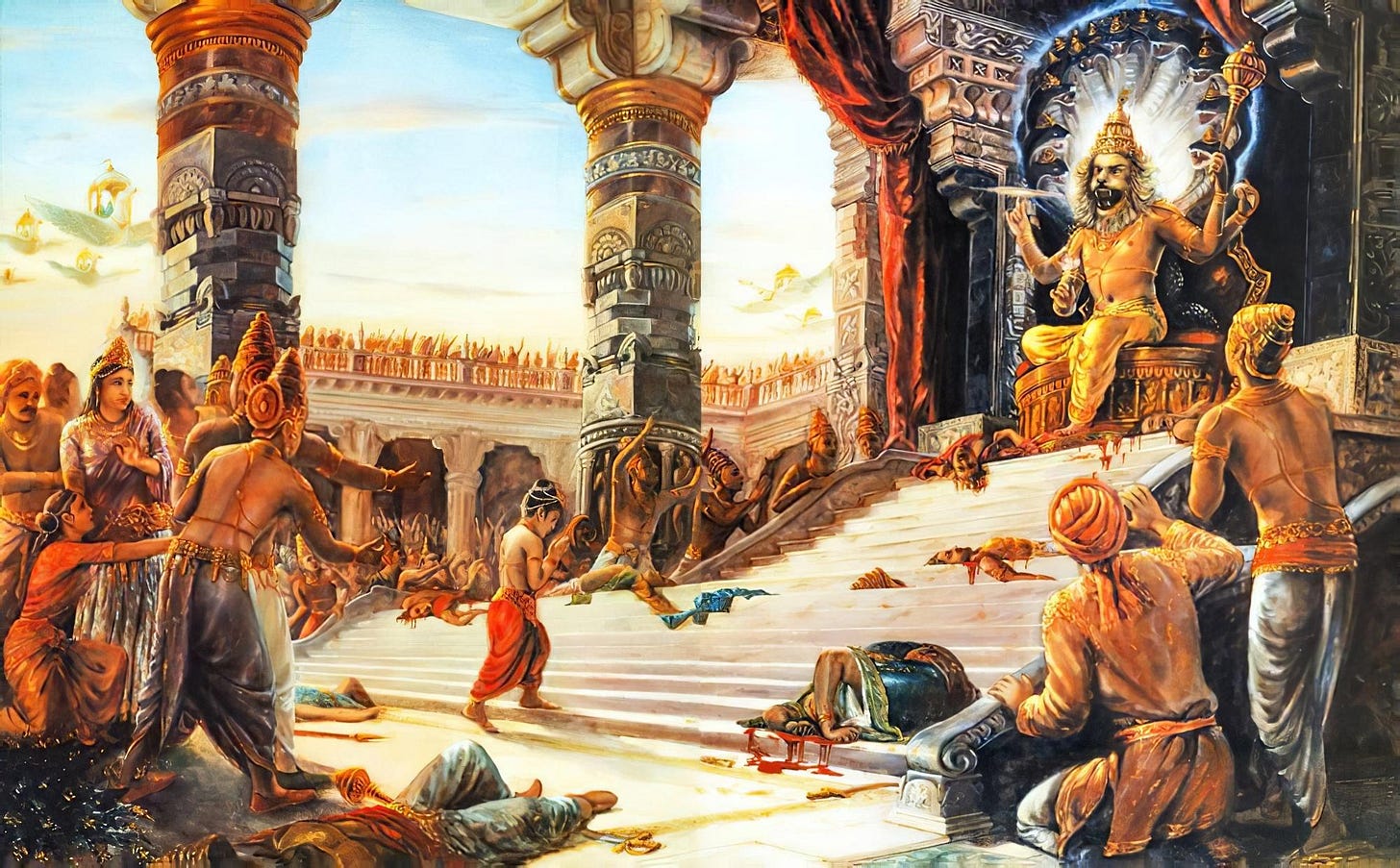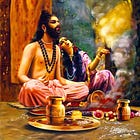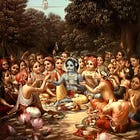Sixteen interesting facts about the pastime of Lord Nṛsiṁhadeva
In Srimad Bhagavatam, we read about the mysterious history of Jaya and Vijaya coming to the material world. Here are a few facts about the pastime you may not know about.
In the Srimad Bhagavatam, we read about the mysterious history of Jaya and Vijaya, and how these two powerful associates of the Lord in Vaikuṇṭha ended up coming to the material world to play the role of demons for three lives, becoming at first Hiraṇyakaśipu and Hiraṇyākṣa, then Rāvaṇa and Kumbhakarṇa, and finally Śiśupāla and Dantavakra, after which they were finally reinstated in their original positions after being killed by Krsna.
For those who observed Śiśupāla being killed by Krsna at the sacrifice of Maharaja Yudhiṣṭhira, it appeared that Śiśupāla merged in the Lord's bodily effulgence, attaining the impersonal Brahmajyoti, but in his purports (7.1.20) Prabhupada explains that "Śiśupāla and Dantavakra were formerly Jaya and Vijaya, the doorkeepers of Vaikuṇṭha. Merging into the body of Kṛṣṇa was not their final destination. For some time they remained merged, and later they received the liberations of sārūpya and sālokya, living on the same planet as the Lord in the same bodily form."
Hiraṇyakaśipu and Hiraṇyākṣa appeared about 400 million years ago, during the reign of Cākṣuṣa Manu (the 6th Manu in the sequence, immediately before the current one). Chronologically speaking, this is after the rebirth of Daksa. The history is that the first birth of Daksa happened at the beginning of the current day of Brahma, during the reign of Svāyambhuva Manu. In this birth, he offended Lord Shiva and ended up being killed by Vīrabhadra, and was later revived with the head of a goat. Although he used this body to conclude the sacrifice he was making, he later left this body due to shame (it's probably not easy to live with the head of a goat). Other pastimes described in the Srimad Bhagavatam, such as the appearance of Lord Kapila and the pastime of Dhruva Maharaja, also happened around this time, during the reign of Svāyambhuva Manu.
The next birth of Daksa happened later in the first Manvantara, as the son of the Pracetas. In this second birth, he first practiced austerities for several Manvantaras to be reinstalled as a Prajapati, which happened only much later, during the reign of Chakususa Manu. He then married Pāncajanī and begot 10,000 sons with the purpose of increasing the population of the universe. All these sons, however, decided to take Sannyāsī after being instructed by Nārada Muni. Daksa then begot 1,000 more sons, just for the same thing to happen again. Frustrated, he cursed Nārada Muni and begot sixty daughters who were married to great sages and became the mothers of most of the population of the universe.
Seventeen of these daughters were married to Kaśyapa Muni, including Diti, who became the mother of Hiraṇyākṣa and Hiraṇyakaśipu.
Here are a few more details about this pastime that you may find interesting:
1- Hiraṇyākṣa moved the earth out of orbit by extensively mining the planet for gold. Srila Prabhupada explains that the different planets float in space due to a delicate combination of forces that are not very well understood by modern scientists. According to him, the current mining of oil and other natural resources has the potential to also disturb the orbit of the planet, bringing unforeseen consequences.
2- As demons, Hiraṇyākṣa and Hiraṇyakaśipu were actually more firmly fixed in meditation on the Lord than even the most advanced devotees. This was possible because they were actually eternal associates of the Lord.
3- Although a demon, Hiraṇyakaśipu begot such a pure son as Prahlāda Maharaja because Nārada Muni appeared as a bird when he was conceiving the baby and started chanting the name of Lord Vishnu. This made Hiraṇyakaśipu meditate very strongly on Lord Vishnu (although in anger) during the sexual act, and as a result, he got a powerful Vaishnava as his son. This illustrates the importance of having a devotional attitude when conceiving a baby.
4- Although born in the high planetary systems as the son of Diti and Kaśyapa Muni, Hiraṇyakaśipu was living in Sutala-loka, which is part of the birlā-svarga (the artificial heavens in the lower planetary systems) with other asuras. After the death of Hiraṇyakaśipu, Prahlāda Maharaja became the king there.
5- When Hiraṇyākṣa was killed, Hiraṇyakaśipu spoke good philosophy to his aggrieved relatives, explaining about the soul and telling them the story about Yamaraja appearing as a child to the lamenting queens of a king killed in battle. Prabhupada comments that at those times, even demons were instructed in the spiritual science. Srila Prabhupada mentions that "The demons are considered highly elevated in knowledge, but because they do not use their good intelligence for the service of the Lord, they are called demons." (7.2.21)
6- At this time, Hiraṇyakaśipu also sent the demons to attack Brahmanas and Vaishnavas and destroy Brāhminical culture on Earth. His idea was to weaken the demigods and Lord Vishnu by depriving them of the sacrificial offerings. Srila Prabhupada compares these efforts with the environment in current times, where many governments in the world encourage sinful activities and oppose the spreading of Krsna Consciousness.
7- When Hiraṇyakaśipu was away, performing his austerities, the demigods attacked his abode. Routed, the demons ran without even taking the women and children, and the demigods used this opportunity to take captive the wife of Hiraṇyakaśipu, who was at the time pregnant with Prahlāda. Fearing that the baby would be another powerful demon, like the father, Indra decided to kill him in the womb, but Nārada Muni protected him, revealing to Indra that he was actually a pure devotee.
8- After protecting Prahlāda, Nārada Muni took the wife of Hiraṇyakaśipu to his āśrama, where he kept her protected until the return of Hiraṇyakaśipu. During this time, Prahlāda was listening from inside the womb as Nārada instructed his mother about devotional service. That's how Prahlāda became such a great devotee. The mother forgot everything she heard, but Prahlāda remembered. Interestingly enough, Hiraṇyakaśipu was very grateful to Nārada Muni for protecting his wife and did not suspect that he had instructed Prahlāda on the transcendental science.
9- Although being born into a family of demons, Prahlāda was sent to the gurukula. This happened because demons in the birlā-svarga also follow a form of Varnāśrama system, called asura-varnāśrama. The main difference compared with the daiva-varnāśrama followed by devotees is that this is a system based on fruitive activities and on a form of hereditary caste system. They have Brahmanas and gurus, but these are all materialists. In the gurukula, Prahlāda was being trained in fruitive activities and political maneuverings, but he rejected these teachings and started instead teaching his classmates about Lord Vishnu. In Kali-yuga, asuras are born on Earth in Brahmana families, and the asura-varnāśrama is propagated in the form of the caste system, a system denounced by all our ācāryas.
10- Hiraṇyakaśipu tried to kill Prahlāda Maharaja by all possible means, including ordering his associates to attack him with weapons, trying to crush him by using elephants and throwing him off cliffs, trying to poison him, frying him in boiling oil, and so on. However, in all these attempts, Prahlāda remained unharmed due to the protection of the Lord. Eventually, Hiraṇyakaśipu decided to kill Prahlāda himself, and that's when Lord Nṛsiṁhadeva appeared.
11- After being blessed by Lord Brahma, Hiraṇyakaśipu took possession of the celestial planets and started living in the palace of Indra and enjoying the Nandana gardens (SB 7.4.8). In this way, the battle between him and Lord Nṛsiṁhadeva happened on the celestial planets and not on Earth.
12- The battle between Lord Nṛsiṁhadeva and Hiraṇyakaśipu took a very long time, at least according to time on Earth. Lord Nṛsiṁhadeva appeared at around midday, and Hiraṇyakaśipu was killed at dusk. It happens that on the celestial planets, 24 hours equals 360 days on Earth; therefore, the battle took about 90 days of our time.
13- With the exception of Lord Vishnu, Brahma, and Shiva, Hiraṇyakaśipu was able to subdue everyone on the upper planets, including the great sages and even Nārada Muni, engaging them in their glorification. Normally, great sages like Bhṛgu have the power to curse and thus kill any kind of demoniac ruler, like in the case of Vena, but they were powerless against Hiraṇyakaśipu because he became more powerful than any of them due to his austerities (SB 7.4.13). Srila Prabhupada comments that sometimes in this material world, great personalities, or even great devotees, can fall under the control of asuras and be forced to serve them. When this happens, they can only pray to the Lord for their deliverance. These rulings by the demons can thus serve to increase our meditation and devotion to Krsna.
14- Hiraṇyakaśipu became so powerful that he was able to take charge of different functions of the universe, including the pouring of rains, the movements of the sun, and so on, without depending on the cooperation of the demigods (SB 7.4.18). However, he remained under the control of his senses. Later, Prahlāda Maharaja mentioned this fact, saying "In former times there were many fools like you who did not conquer the six enemies that steal away the wealth of the body." and "Except for the uncontrolled and misguided mind, there is no enemy within this world." (SB 7.8.9-10), which deeply angered Hiraṇyakaśipu. Often, the naked truth can be more disturbing than any offense.
15- Srila Prabhupada explains that Prahlāda Maharaja simultaneously lives in Sutala and in Vaikuṇṭha Loka. This quality of existing simultaneously in different places is a prerogative of the Lord, but very exalted devotees like Prahlāda Maharaja become, by their devotional service, almost as powerful as the Lord, and can thus perform such feats that are impossible for ordinary souls. Although Prahlāda lives eternally in Vaikuṇṭha, at the same time, he appears in the different material universes to play his pastime with Lord Nṛsiṁhadeva. The role of Hiraṇyakaśipu is played each time by a different soul, but Prahlāda Maharaja is always the same. By ruling the planetary system of Sutala and living amongst the demons, he also gives them an opportunity to become devotees of Lord Vishnu.
In his purports, he mentions that: "From authoritative scripture it is learned that Prahlāda Mahārāja still lives in Vaikuṇṭhaloka as well as within this material world on the planet Sutala. This transcendental quality of existing simultaneously in different places is another qualification of the Supreme Personality of Godhead. Goloka eva nivasaty akhilātma-bhūtaḥ: the Lord appears in the core of everyone’s heart, yet He exists on His own planet, Goloka Vṛndāvana. A devotee acquires qualities almost the same as those of the Lord because of unalloyed devotional service. Ordinary living beings cannot be so qualified, but a devotee can be qualified like the Supreme Personality of Godhead, not in full but partially." (7.4.34)
16- Just like in the case of Prahlāda Maharaja, this quality of being simultaneously in different places is exhibited by other eternally liberated associates of the Lord, such as Nārada Muni and Dhruva Maharaja, who appear in the different material universes while at the same time remaining fixed in their original positions in the spiritual world.
If you read this article to the end, give it a like or write a commentary. This makes Substack recommend it to more people.
Read also:






Hare Krishna prabhuji PAMHO 🙏
In Ahobilam Dham, there is a pillar called Ugra Stambha, which Sri Vaishnavas and ISKCON devotees claim to be the exact pillar from which Narsimhadev appeared.
In this article prabhuji you claim that combat took place in Svarg where Hiranyakasipu lived after subduing Indra, which means pillar should've been in Svarg. Now, this seems contradictory. Kindly clarify prabhuji.
Your servant Ishanth
Hare Krishna Prabhu ji 🙏 informative article. Thank you prabhu ji